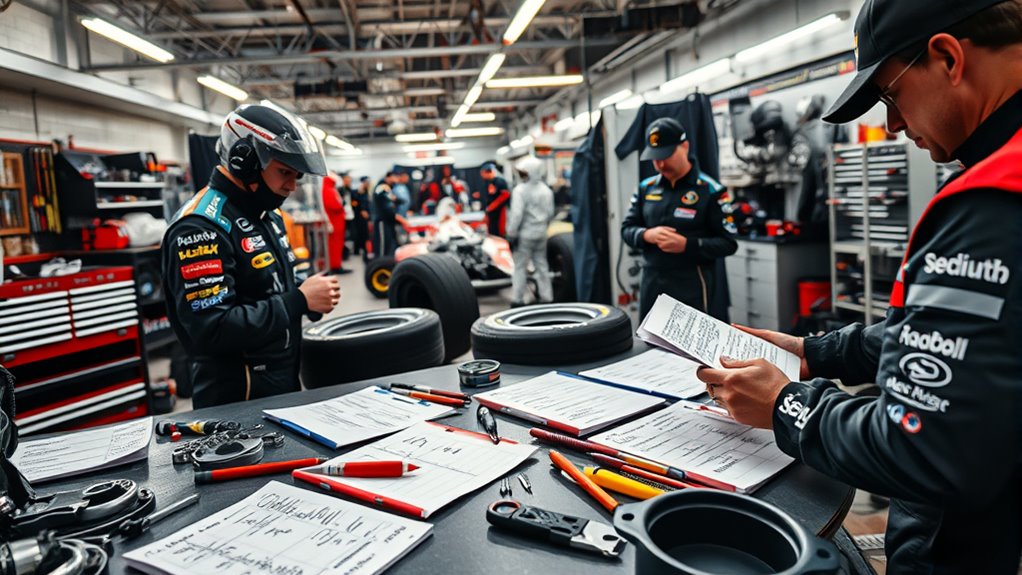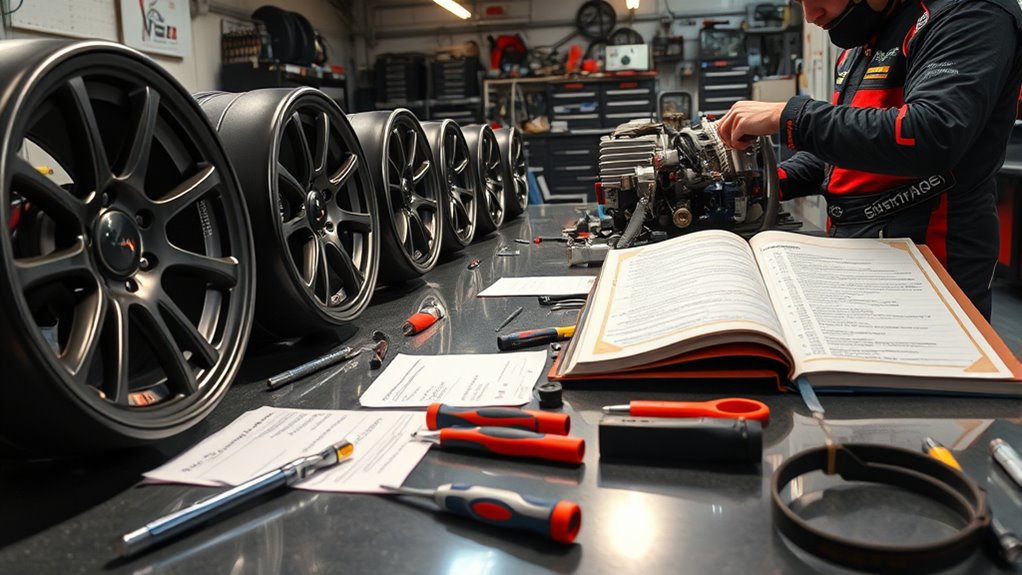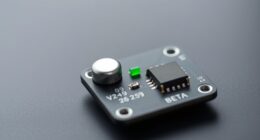After each race, you should carefully disassemble your vehicle, inspecting all parts for damage or wear. Clean components thoroughly to remove dirt and prevent rust, and lubricate moving parts for smooth operation. Check key systems like brakes, suspension, and electronics, ensuring everything functions correctly and is properly tightened. Document any issues and repairs needed. Proper tear-down not only keeps your vehicle safe and reliable but also optimizes performance—learn more to perfect your post-race routine.
Key Takeaways
- Carefully disassemble bodywork and panels, noting any cracks, dents, or loose fasteners for repair or replacement.
- Clean all components thoroughly to remove dirt and corrosion, inspecting for cracks or damage during the process.
- Lubricate moving parts and perform mechanical checks on suspension, brakes, and drivetrain for wear or stress signs.
- Verify safety equipment functionality and reassemble the vehicle, ensuring all fasteners are properly torqued and systems operational.
- Document issues, repairs, and parts replaced; store equipment properly and plan routine inspections for ongoing vehicle safety and performance.
Post-Race Equipment Inspection and Maintenance

After a race, performing a thorough tear-down is essential to keep your equipment in top shape and guarantee safety for future events. You want to catch any damage early, prevent corrosion, and assure everything is ready for the next competition. Start by carefully removing the bodywork or panels, taking note of any cracks, dents, or loose fasteners. Handle parts gently to avoid causing further damage, and keep track of all hardware—organized containers or labeled bags work well for small parts. As you remove components, inspect each for signs of wear or stress. Pay close attention to the suspension, brakes, and drivetrain, as these are critical for performance and safety.
Perform a careful tear-down post-race to ensure safety, spot damage early, and maintain peak vehicle performance.
Next, clean each part thoroughly. Use appropriate cleaners to remove dirt, mud, or grease, which can hide underlying issues. A pressure washer can be helpful but avoid soaking sensitive electronics or bearings. Dry everything completely to prevent rust and corrosion. Once clean, examine parts closely for cracks, corrosion, or any abnormalities. Replace or repair damaged components promptly to prevent failures during your next race. Lubricate moving parts as needed, especially bearings, pivots, and joints, to keep them operating smoothly.
When handling the engine and transmission, follow manufacturer guidelines for inspection and service. Check fluid levels, replace filters if necessary, and look for leaks or signs of overheating. Remove spark plugs and inspect their condition; this can give you clues about the engine’s health. Be sure to also inspect the cooling system, radiator, and hoses for leaks or damage. Maintaining these parts ensures peak performance and prevents overheating issues later. Additionally, understanding how to interpret individual evidence can sometimes aid in diagnosing issues or confirming the integrity of critical components.
Don’t forget about safety equipment. Check your helmets, suits, and harnesses for wear or damage, and replace anything compromised. Inspect fire extinguishers and safety gear to ensure they’re fully functional. Once everything is cleaned, inspected, and repaired, reassemble the vehicle carefully, ensuring all bolts and fasteners are torqued to specifications. Double-check all systems—brakes, steering, suspension—to confirm everything’s reassembled correctly and ready for the next race.
Finally, document your tear-down process. Note any issues found, repairs made, and parts replaced. This record can help track recurring problems and plan maintenance schedules. Storing your equipment in a clean, dry environment after tear-down also extends its lifespan. Performing this routine after every race keeps your vehicle in excellent condition, reduces unexpected breakdowns, and boosts your confidence on race day. Staying diligent with your tear-down process isn’t just about maintenance; it’s about ensuring safety, performance, and long-term success for your team.
Frequently Asked Questions
How Often Should Tear-Down Procedures Be Reviewed for Accuracy?
You should review tear-down procedures regularly to guarantee they’re accurate and effective. Ideally, do this before each race season and after significant changes in equipment or team members. Regular reviews help catch errors and improve safety. Also, consider revisiting the checklist after races or maintenance sessions. Staying proactive ensures your team stays prepared, minimizes mistakes, and maintains high standards throughout the racing season.
What Safety Precautions Are Essential During Tear-Down?
Did you know that nearly 30% of racing injuries happen during tear-down? During this process, you should always wear personal protective equipment like gloves, goggles, and steel-toed boots to prevent accidents. Use proper tools and follow established procedures carefully. Keep your workspace organized, stay alert, and never rush. By taking these precautions, you diminish risks and guarantee a safer tear-down, protecting yourself and your team.
How Are Tear-Down Findings Documented for Future Reference?
You should document tear-down findings by recording detailed notes on any issues or damages discovered. Use a standardized form or digital system to guarantee consistency and easy retrieval later. Include photos if possible, and note the location and severity of problems. This documentation helps track recurring issues, inform repairs, and improve future race preparations. Make sure your team reviews and stores these records securely for future reference.
Who Is Responsible for Final Approval After Tear-Down?
You might think the team lead or engineer approves the tear-down, but surprisingly, it’s actually the race director’s call. After you finish the tear-down, you submit your findings for validation—yet, the final nod comes from someone outside your immediate team who ensures everything complies with regulations. It’s ironic how the person overseeing the process isn’t the one doing the work but holds the ultimate authority to approve it.
What Tools Are Recommended for Efficient Post-Race Tear-Down?
To guarantee an efficient post-race tear-down, you should use the right tools. A set of high-quality wrenches, screwdrivers, and socket sets will speed up disassembly. Additionally, use magnetic trays to organize small parts and torque wrenches to verify fastener tightness. Keep a power drill with appropriate bits handy for quicker removal of bolts. Proper tools help you work faster, stay organized, and avoid damaging components during tear-down.
Conclusion
After each race, think of your tear-down as tending to a wounded warrior—repair and inspect with care to keep it fighting strong. Skipping this step is like leaving a cracked shield vulnerable; it risks future performance and safety. Embrace the routine, knowing it’s the heartbeat of your team’s success. When you give your equipment the love and attention it deserves, you’re nurturing a champion that rises stronger after every race.









